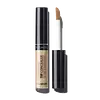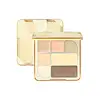What's inside
What's inside
 Key Ingredients
Key Ingredients

 Benefits
Benefits

 Concerns
Concerns

 Ingredients Side-by-side
Ingredients Side-by-side

Water
Skin ConditioningTitanium Dioxide
Cosmetic ColorantCyclopentasiloxane
EmollientPhenyl Trimethicone
Skin ConditioningTalc
AbrasiveButylene Glycol
HumectantCetyl PEG/PPG-10/1 Dimethicone
EmulsifyingPvp
Emulsion StabilisingCI 77492
Cosmetic ColorantPEG-10 Dimethicone
Skin ConditioningVinyl Dimethicone/Methicone Silsesquioxane Crosspolymer
Sodium Chloride
MaskingAluminum Hydroxide
EmollientTriethoxycaprylylsilane
Disteardimonium Hectorite
StabilisingStearic Acid
CleansingPhenoxyethanol
PreservativeCI 77491
Cosmetic ColorantChlorphenesin
AntimicrobialDimethicone
EmollientCI 77499
Cosmetic ColorantParfum
MaskingCalamine
AbsorbentEctoin
Skin ConditioningMannitol
HumectantYeast Extract
Skin ConditioningAlcohol
AntimicrobialCentella Asiatica Leaf Extract
Skin ConditioningGlycogen
HumectantMagnesium Ascorbyl Phosphate
AntioxidantAloe Barbadensis Leaf Extract
EmollientArnica Montana Flower Extract
MaskingGentiana Lutea Root Extract
Skin ConditioningAchillea Millefolium Extract
CleansingArtemisia Vulgaris Extract
Skin ConditioningGlycerin
HumectantPotassium Sorbate
PreservativeCitric Acid
BufferingSodium Benzoate
MaskingWater, Titanium Dioxide, Cyclopentasiloxane, Phenyl Trimethicone, Talc, Butylene Glycol, Cetyl PEG/PPG-10/1 Dimethicone, Pvp, CI 77492, PEG-10 Dimethicone, Vinyl Dimethicone/Methicone Silsesquioxane Crosspolymer, Sodium Chloride, Aluminum Hydroxide, Triethoxycaprylylsilane, Disteardimonium Hectorite, Stearic Acid, Phenoxyethanol, CI 77491, Chlorphenesin, Dimethicone, CI 77499, Parfum, Calamine, Ectoin, Mannitol, Yeast Extract, Alcohol, Centella Asiatica Leaf Extract, Glycogen, Magnesium Ascorbyl Phosphate, Aloe Barbadensis Leaf Extract, Arnica Montana Flower Extract, Gentiana Lutea Root Extract, Achillea Millefolium Extract, Artemisia Vulgaris Extract, Glycerin, Potassium Sorbate, Citric Acid, Sodium Benzoate
Polymethacrylic Acid Crosspolymer
AbsorbentCI 77891
Cosmetic ColorantGlycerin Methyl Ether
Mica
Cosmetic ColorantPolyglyceryl-2 Triisostearate
EmulsifyingParaffin
PerfumingSilicon
AbrasiveMicrocrystalline Wax
Emulsion StabilisingPolymethyl/Phenylsilsesquioxane Silicate
Lauryl Alcohol Diphosphonic Acid
Emulsion StabilisingPolydiethylsiloxane
EmollientC8-12 Acid Triglyceride
Skin ConditioningHydrogenated Vegetable Oil
EmollientIsooctane
SolventSynthetic Wax
AbrasiveCI 77492
Cosmetic ColorantCitric Acid
BufferingCI 77499
Cosmetic ColorantSucrose Tetrastearate Triacetate
EmollientCI 77491
Cosmetic ColorantEthylene/Acrylic Acid Copolymer
Emulsion StabilisingEuphorbia Cerifera Cera
AstringentGlycerin
HumectantCopernicia Cerifera Wax
Butyrospermum Parkii Butter
Skin ConditioningSimmondsia Chinensis Seed Powder
Skin ConditioningSilica
AbrasiveBoron Nitride
AbsorbentMicrocrystalline Cellulose
AbsorbentMagnesium Dna
Skin ConditioningCinoxate
UV AbsorberPolysilicone-3
Skin ConditioningAluminum Hydroxide
EmollientMacadamia Ternifolia Seed Oil
EmollientButoxyethanol
MaskingMethyl Methacrylate Crosspolymer
Aluminum Starch Octenylsuccinate
AbsorbentPentaerythrityl Tetra C5-9 Acid Esters
Skin ConditioningPentylene Glycol
Skin ConditioningVinyldimethyl/Trimethylsiloxysilicate
Ethylhexyl Ester Of Tetradecene/Hexadecene/Ma Copolymer
Skin ConditioningHydrogenated Methyl Abietate
Polysilicone-10
Polyethylene
AbrasivePhenol
AntimicrobialMethyl Trimethicone
Skin ConditioningMagnesium Sulfate
Sodium Ethylparaben
PreservativeAlumina
AbrasiveCeramide NP
Skin ConditioningEndomyces/Aesculus Hippocastanum Ferment Filtrate
Skin ConditioningGlucose
HumectantHydrogenated Starch Hydrolysate
HumectantGlycol
HumectantTalc
AbrasiveC12-15 Alcohols
EmollientC18-30 Acid Glycol Ester
EmollientSimmondsia Chinensis Seed Oil
EmollientCaprylic/Capric Triglyceride
MaskingEthyl Nicotinate
PerfumingPalm Glyceride
EmollientKaolin
AbrasiveC12-20 Acid PEG-8 Ester
EmulsifyingStearyl Triethoxysilane
Polyglyceryl-8 C12-20 Acid Ester
EmulsifyingLauroyl Lysine
Skin ConditioningLard Glyceride
EmulsifyingEthyl Serinate
Skin ConditioningPolymethacrylic Acid Crosspolymer, CI 77891, Glycerin Methyl Ether, Mica, Polyglyceryl-2 Triisostearate, Paraffin, Silicon, Microcrystalline Wax, Polymethyl/Phenylsilsesquioxane Silicate, Lauryl Alcohol Diphosphonic Acid, Polydiethylsiloxane, C8-12 Acid Triglyceride, Hydrogenated Vegetable Oil, Isooctane, Synthetic Wax, CI 77492, Citric Acid, CI 77499, Sucrose Tetrastearate Triacetate, CI 77491, Ethylene/Acrylic Acid Copolymer, Euphorbia Cerifera Cera, Glycerin, Copernicia Cerifera Wax, Butyrospermum Parkii Butter, Simmondsia Chinensis Seed Powder, Silica, Boron Nitride, Microcrystalline Cellulose, Magnesium Dna, Cinoxate, Polysilicone-3, Aluminum Hydroxide, Macadamia Ternifolia Seed Oil, Butoxyethanol, Methyl Methacrylate Crosspolymer, Aluminum Starch Octenylsuccinate, Pentaerythrityl Tetra C5-9 Acid Esters, Pentylene Glycol, Vinyldimethyl/Trimethylsiloxysilicate, Ethylhexyl Ester Of Tetradecene/Hexadecene/Ma Copolymer, Hydrogenated Methyl Abietate, Polysilicone-10, Polyethylene, Phenol, Methyl Trimethicone, Magnesium Sulfate, Sodium Ethylparaben, Alumina, Ceramide NP, Endomyces/Aesculus Hippocastanum Ferment Filtrate, Glucose, Hydrogenated Starch Hydrolysate, Glycol, Talc, C12-15 Alcohols, C18-30 Acid Glycol Ester, Simmondsia Chinensis Seed Oil, Caprylic/Capric Triglyceride, Ethyl Nicotinate, Palm Glyceride, Kaolin, C12-20 Acid PEG-8 Ester, Stearyl Triethoxysilane, Polyglyceryl-8 C12-20 Acid Ester, Lauroyl Lysine, Lard Glyceride, Ethyl Serinate
 Reviews
Reviews

Ingredients Explained
These ingredients are found in both products.
Ingredients higher up in an ingredient list are typically present in a larger amount.
Aluminum Hydroxide is a form of aluminum. It can be naturally found in nature as the mineral gibbsite. In cosmetics, Aluminum Hydroxide is used as a colorant, pH adjuster, and absorbent.
As a colorant, Aluminum Hydroxide may add opacity, or reduce the transparency. Aluminum hydroxide is contains both basic and acidic properties.
According to manufacturers, this ingredient is an emollient and humectant. This means it helps hydrate the skin.
In medicine, this ingredient is used to help relieve heartburn and help heal ulcers.
There is currently no credible scientific evidence linking aluminum hydroxide in cosmetics to increased cancer risk.
Major health organizations allow the use of aluminum hydroxide in personal care products and have not flagged it as a carcinogenic risk at typical usage levels.
Learn more about Aluminum HydroxideCi 77491 is also hydrated iron III oxide. It's sole purpose is to give a red/pink hue to products.
Iron III oxides are classified as inorganic chemicals for coloring.
Synthetically created Ci 77491 is considered safer than those naturally found. This is because the synthetically created version may contain less impurities. Iron oxides are generally non-toxic and non-allergenic.
Learn more about CI 77491Ci 77492 is also hydrated iron III oxide. It's sole purpose is to give a yellow hue to products.
Iron III oxides are classified as inorganic chemicals for coloring.
Synthetically created Ci 77492 is considered safer than those naturally found. This is because the synthetically created version may contain less impurities. Iron oxides are generally non-toxic and non-allergenic.
Learn more about CI 77492Ci 77499 is also hydrated iron III oxide. It is created from mixing red and black iron oxides. This helps give shades of darkness to a product.
Iron III oxides are classified as inorganic chemicals for coloring.
Citric Acid is an alpha hydroxy acid (AHA) naturally found in citrus fruits like oranges, lemons, and limes.
Like other AHAs, citric acid can exfoliate skin by breaking down the bonds that hold dead skin cells together. This helps reveal smoother and brighter skin underneath.
However, this exfoliating effect only happens at high concentrations (20%) which can be hard to find in cosmetic products.
Due to this, citric acid is usually included in small amounts as a pH adjuster. This helps keep products slightly more acidic and compatible with skin's natural pH.
In skincare formulas, citric acid can:
While it can provide some skin benefits, research shows lactic acid and glycolic acid are generally more effective and less irritating exfoliants.
Most citric acid used in skincare today is made by fermenting sugars (usually from molasses). This synthetic version is identical to the natural citrus form but easier to stabilize and use in formulations.
Read more about some other popular AHA's here:
Learn more about Citric AcidGlycerin is already naturally found in your skin. It helps moisturize and protect your skin.
A study from 2016 found glycerin to be more effective as a humectant than AHAs and hyaluronic acid.
As a humectant, it helps the skin stay hydrated by pulling moisture to your skin. The low molecular weight of glycerin allows it to pull moisture into the deeper layers of your skin.
Hydrated skin improves your skin barrier; Your skin barrier helps protect against irritants and bacteria.
Glycerin has also been found to have antimicrobial and antiviral properties. Due to these properties, glycerin is often used in wound and burn treatments.
In cosmetics, glycerin is usually derived from plants such as soybean or palm. However, it can also be sourced from animals, such as tallow or animal fat.
This ingredient is organic, colorless, odorless, and non-toxic.
Glycerin is the name for this ingredient in American English. British English uses Glycerol/Glycerine.
Learn more about GlycerinTalc is a clay mineral. It helps absorb moisture and improve the texture of products. Like other types of clay, Talc can have a slight exfoliating effect on skin. Talc can be added to increase the volume of products.
Some Baby powders are made by combining talc with corn starch. The word "talc" comes from Latin and originates from Arabic. Talc is a mineral commonly found throughout the world.
If you have any concerns about using talc, we recommend checking out the FDA's official page.
Learn more about Talc